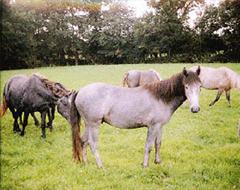Eriskay Pony
N/A
Fri, 15th November, 2024 - 4:53 am GMT
Sponsor Ads:

Alternative Name
N/ABasic Info
Eriskay ponies are very distinctive in that they are usually born black or bay and usually turn grey as they mature, a few individuals have remained black or bay into adulthood, but no other colors occur. They have a dense, waterproof, but not overly long, coat which enables them to live out in the harshest of conditions, and have a little, light feathering on their fine legs. The head is sensible and workmanlike with plenty of room for air to warm in the sinuses before it reaches the lungs, and the tail is low set to keep the hind end warm in the wind and rain.
Health
N/AHabitat
N/ABehavior
The ponies had evolved to survive on meager food supplies, with coats, ears and tails well adapted to coping with a harsh, wet and windy climate. Eriskays were then subject to the forces of living in a society where women and children did most of the work while the men were at sea. Poor temperaments could not be tolerated. Only those ponies happy to live in close proximity with their handlers, those willing to be trained and work hard, were retained. Unsuitable specimens were culled. Over the centuries, the Eriskay ponies evolved into the hardy, versatile, people friendly characters we recognize today. On many of the islands increasing mobility and farming pressures led to larger ponies becoming fashionable. Norwegian Fjords, Arabs, Clydesdales and others were introduced to "improve" the native stocks and produce larger, stronger animals. On the remote island of Eriskay in the Western Isles, however, due to difficulties with access, other breeds were not introduced, leaving a stock of pure bred ponies which had declined to a around 20 animals, due to mechanizationOrigin
ScotlandHistory
The Eriskay Pony is the only surviving variety of Hebridean pony and are found on the Hebrides islands off the coast of Scotland. They originated from the Celtic type with no imported bloodlines. The Eriskay pony is almost extinct. Modern Eriskay ponies are the last surviving remnants of the original native ponies of the Western Isles of Scotland. Recent DNA testing by the University of Leicester has proven that they are a distinct, primitive breed, with ancient origins. Certainly they have ancient Celtic and Norse connections and Eriskays have been proven by measurement to be of similar proportions to those found on ancient Pictish stones throughout the North and West of Scotland. Until the middle of the 19th Century ponies of the "Western Isles type" were found throughout the islands and used as crofters ponies, undertaking everyday tasks such as bringing home peat and seaweed in basketwork creels slung over their backs, pulling carts, harrowing and even taking the children to school. was at this time that a dedicated group of people comprising a local priest, doctor, vet, zoologist and crofters, got together and decided to save the ponies whose numbers were dangerously low. Through their hard work and the establishment of breeding groups throughout the British Isles, numbers have risen steadily and now there are around 300 Eriskays in the world. Obviously, the breed are still seriously threatened and are listed by the Rare Breeds Survival Trust as category 1 "critical", but with 12 pure bred stallions and a record 25 foals born last year, the future is looking a little brighter.Common Foods
grassSponsor Ads:
Thoughts on Programming, Number 13: In some terminal systems ... the user can keep his program from being pushed down in the priority stack by fiddling with the shift key while he is thinking. -The Psychology of Computer Programming, Gerald M. Weinberg
Eriskay Pony
Coded by: BGID® | ALL RIGHTS RESERVED Copyright © 2000-2024
Disclaimer | Privacy | Report Errors / Contact | Credits

 Politician, US Vice President and President of the USA - Joseph Robinette Biden Jr.
Politician, US Vice President and President of the USA - Joseph Robinette Biden Jr.  President of the United States of America - Real Estate mogul, Pageant owner and now one of the most controversial men in political history.
President of the United States of America - Real Estate mogul, Pageant owner and now one of the most controversial men in political history.  versus
versus  Russia: 'The Evil Empire'? Are they all that bad or is it just the USA trying to portray Russia as bad because they are a world power with land bigger and a society very different from the USA ideal?
Russia: 'The Evil Empire'? Are they all that bad or is it just the USA trying to portray Russia as bad because they are a world power with land bigger and a society very different from the USA ideal?  Global warming has been in and out as the "latest" hot topic for many years. It is, according to modern scientists, the result of man-made industrial pollutants, clearing forested areas, agriculture, etc. But now they are thinking it started way before the Industrial Revolution...
Global warming has been in and out as the "latest" hot topic for many years. It is, according to modern scientists, the result of man-made industrial pollutants, clearing forested areas, agriculture, etc. But now they are thinking it started way before the Industrial Revolution... 
 Corona virus
Corona virus 
 Users with wide screen monitors can benefit from more content on every page.
Users with wide screen monitors can benefit from more content on every page.